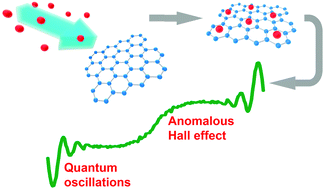2D ferromagnetism in europium/graphene bilayers†
Abstract
Intrinsic functionality of 2D materials is crucial for both fundamental studies and practical applications. In particular, 2D magnetism has recently emerged as a major research field bringing in new concepts, physical effects, and device designs. However, the list of stoichiometric 2D magnets is still rather short and would benefit from extension by magnetic graphene derivatives. Here, the graphite intercalation compound EuC6 is scaled down to an Eu/graphene bilayer, an approach inspired by studies of magnetic Eu/silicene (EuSi2) and Eu/germanene (EuGe2). The material, synthesized by Eu deposition on graphene, exhibits 2D ferromagnetism evidenced by low-magnetic-field control over the effective transition temperature. The ferromagnetic state is further manifested by the emergence of negative magnetoresistance and an anomalous Hall effect. Remarkably, induced magnetism does not destroy the parental electronic structure – in the Eu/graphene bilayer, quantum oscillations reveal low-mass carriers, a property inherited from graphene. The material can make an important ingredient of van der Waals heterostructures to be applied in ultracompact spintronics and quantum computing.

- This article is part of the themed collection: Horizons Community Board Collection: Advanced Memory Technologies


 Please wait while we load your content...
Please wait while we load your content...